Wind-swept Wandering on the Mediterranean
Originally published on November 1, 2013
in
The Press Tribune
Sometime around 850 B.C., the Greek poet Homer first mused about the seduction of a “wine dark sea,” forever linking Dionysian vines to the flaming colors of a Mediterranean evening.
Homer’s world has changed, though it’s still a picture of swaying rugged vineyards, flinty wave-cut shores and cracked pillars under endless skies. The people are warm. The food is incredible. The wine is flowing. History feels like it’s breathing on you. From Adriatic waves to Ionian sunsets, the lands of “The Odyssey” have kept their mystery, as well as lessons on living for the modern seafarer.
Athens
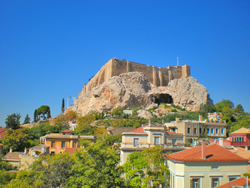
The Plaka district in Athens. By S.T.A.
Athens is an ideal place to start venturing through the Old World. Today, the birthplace of western civilization is a massive city with high unemployment, endemic poverty and a timeless café culture that can make you fall in love with its crush of hardened faces drinking from afternoon to evening. Tour books can tell you which museums and ruins to flock to; but mastering the art of living like an Athenian is something entirely different. To start with, Greeks don’t streak through dinner like American lightening — rather each meal unfolds slowly, allowing them to savor the sounds of the city and the nuances of the night.
My favorite dining experience in Athens is a little hideaway called Xenios Zeus: Tucked into a quiet, backstreet above the Roman Agora, this restaurant has olive trees wrapping through its secluded patio under a towering view of the Acropolis, which the city illuminates like an ancient gold mountain under the stars. The best way to sum-up Greek cuisine is exquisite simplicity: Xenios Zeus fits that bill, offering flamed-licked pork souvlaki, salted olives, crisp spinach pie, tangy hummus and plenty of glasses of their house red wine, which is served cold and tastes like an icy Grenache mixed with a quarter of Lambrusco.
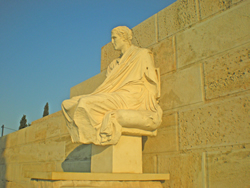
An statue of a poet at the Acropolis. By S.T.A.
For those travelers determined to eat in the busy Plaka district — with its smiling Bouzouki musicians and rows of revelers in front of cafés — avoiding a tourist trap means finding a small joint at least five minutes from the action. The family-owned Taverna Saita is a restaurant that won’t disappoint. Haunted by real Athenians, Taverna Saita is known for succulent stewed lamb served in lemon and herb sauce, so tender that the meat flakes right off the bone. It also offers a slow-roasted egg plant, cut with tomato sauce and onions and topped with huge chunks of feta cheese. It’s the kind of place where people will be laughing and guzzling Mythos beer until odd hours of the morning.
Down the way from Taverna Saita is an example of just how cosmopolitan Athens’s nightlife has become: Cine Paris is an outdoor, rooftop cinema that plays films from around the world. Travelers can fill up on cappuccinos and baklava in the cluster of cafés below before watching the visions of filmmakers from Paris to New York, all while surrounded by gardens, stone rooftops and the open night. On the evenings I was hanging around Cine Paris, it was featuring Woody Allen’s character study, “Blue Jasmine.”
Hydra
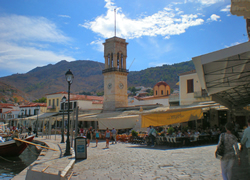
The Greek Island of Hydra. By S.T.A.
Hydra is the type of island the Greek refugee Ulysses could be blown onto and then never want to escape. East of Argos, Hydra is one of the most meditative, scenic and serene stops in the entire Peloponnese. The island has no automobiles, so its main modes of transportation are small boats and surly donkeys. The edge of the island’s port is lined with quaint cafes and busy seaside bars where locals gaze at yachts cutting over the crystal blue waves. Hiking trails riddle its scrubby, sun-blistered hills, and several lonely beaches stretch between its low brush and the water.
Amidst Hydra’s whitewashed walls straddled by cats, travelers can find some of the best Greek dining in the region. Taverna Gitoniko is a paragon in this arena, with a down-home rooftop terrace laced in hanging vines. Owned by islanders Manolis and Christiana, the restaurant specializes in fresh-from-the-waves seafood and the Greek staple, moussaka. Non-philistines know moussaka is a baked casserole with stuffed layers of eggplant, beef and white cheese sauce. At Gitoniko, Christiana brings it to the tables in a steaming pan, its top firm and fluffy, while its body holds the juices without a hint of sogginess. Moussaka is a perfect motivation for late night walks along the breezy port.
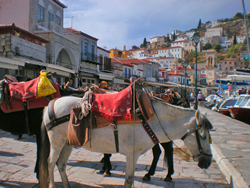
The small port at Hydra. By S.T.A..
Hydra’s uncanny quietness has made it a haven for creative spirits. Painters, jewelers, sculptors and silversmiths have cave-like shops along the town’s narrow alleys. If you chat with these artists long enough, you’ll notice they spend their lunches dropping by small cooking hubs for “mezedes,” which are dishes meant to be shared. To-Paradosiako, a rustic white and blue tavern, cooks up quintessential mezedes. Greeks love seafood, and if you crowd around To-Paradosiako you can grab plates of marinated sardines drowned in pools of butter, chopped garlic, oil, spices and lemon juice. You can also opt for the grilled Octopus, lobbed into fat chunks with the tentacles’ suction cups blackened by heat and fried butter.
After lunch, it’s back to Hydra’s clutter of seaside cafes, kicking back, downing Ouzo and wondering why Americans have to live at hyper-speed.
Venice
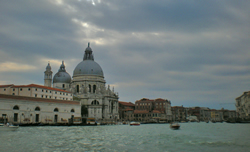
Venice's Grand Canal meets the Lagoon. By S.T.A.
Writers have argued about which is the most romantic city in the world: Paris or Venice? The debate will go on, but Italians know that Venice in the rain is like Paris in the rain — brooding, mysterious and captivating in its faded, ornate grandeur.
Venice is a cluster of wave-bound palaces. At night, darkness envelops the Grand Canal and streams of lamps and table candles along the water glow amber on the medieval arches and Adriatic balconies, until you can see the torched illumination reflecting on gentle waves cut by passing gondolas. It’s a city where you can spend an evening steering down crumbling corridors and across footbridges that drape silent, shadowed canals.
Between the Doge’s Palace, the Guggenheim and the Gallerie dell’ Accademia, Venice holds some of the greatest art collections in all of Italy. It also has plenty of gritty Gothic churches lifting marble spires across its skyline. Crime is low in the city, but if you try to eat at any place called a “ristorante” near Saint Mark’s Square you will certainly be robbed. For delicious food at a reasonable price seek out Venice’s small, indie-style “trattorias.” Trattoria La Rosa Dei Venti, along a back canal of Santa Maria, is just such a place: Its dining room feels like a family gathering, and its chefs know how to make an egg-heavy Carbonara with strong accents of bacon and light, phantom spices. True to Venetian tastes, the trattoria also serves up a peppery seafood cioppino stew, loaded with shrimp, clams, muscle and squid. Bearing the final mark of a good trattoria, La Rosa Dei Venti has no shortage airy, flavorful red wine, served cold in liter vases.
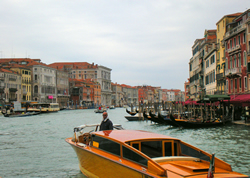
A Venetian boatman. By S.T.A.
It is worth noting Venetians have immense pride in their sinking city. They’re friendly to travelers who are civil, but they have no issues confronting strangers who act the fool. Don’t be surprised to watch attendants on the Vaporetto berate people in Italian for slamming their bags into other pedestrians, or not watching children near the water. Be it foreigners or Italians, the Venetians have no tolerance for public idiocy.
Exploring Venice’s canals with the right gondolier is paramount. A guide worth his oars can bring you right up along the weathered mansions once owned by Marco Polo, Casanova and Lord Byron. Gondoliers posted near Saint Mark’s Square are within walking distance of the Church of San Giovanni in Bragora, filled with a stirring collection of Renaissance paintings and statues. The neighborhood also has a chic little trattoria called Bacarando Ai Corazzieri. This cozy spot plays American Jazz and exudes Italian charm, serving up a bowls of gnocchi and beef cooked in red bologna sauce and sharp cabernet wine. The hardworking chefs can also drop a whole-baked, salt-crusted sea bass at your table, leaving it staring up with charred eyes as you inhale the café’s nitro-flame, homemade grappa.
Dubrovnik and Corfu
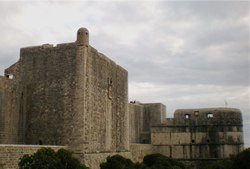
The ancient walls of Dubrovnik. By S.T.A.
The Venetian Empire once stretched well into Croatia and the western Greek islands. Today, sailing down the Adriatic Sea, travelers can spend their days in amazing cultural nexus points. Croatia’s Dubrovnik is probably the most surreal Medieval setting in the entire Mediterranean — a walled castle-city looming on the edge of the water. Americans may better know Dubrovnik as where HBO films its King’s Landing scenes for the popular television series, “Game of Thrones.”
Croatians understand there’s a difference between tourists and travelers: A tourist spends a few minutes on top of the ancient wall and then heads to the glutton of gift shops to buy postcards and cheap shot glasses. To be a real traveler, I recommend sea kayaking along the rocky outer walls of the castle. Keep in mind the Croatian kayaking guides hate each other, and have elevated their personal grudges to the level of assuring each prospective customer their rival is sure to drown them in the bay. It’s not uncommon for the kayaking guides to call the police on each other. In fact, watching the operatic drama between the guides is some of the best entertainment in the old quarter. Once you’ve picked which fast-talker you’ll anchor your fate to, the wave-tossed views of Dubrovnik and the high, wooded mountainsides beyond are breathtaking.
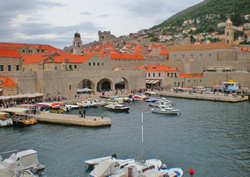
The port in Dabrovnik's oldest quarter. By S.T.A.
Croatia is also rising in the world of Adriatic wines: On a jagged back alley of Dubrovnik you can see what the excitement is about at D’Vino Wine Bar. Dim, snug and intimate, this bar pours regional wine flights and glasses of Boris Violic and Kitokret. The aficionados at D’Vino come off as Euro-hipsters, but in the friendliest and most knowledgeable way.
Sailing south of Dubrovnik, you come to the island of Corfu, a sliver of Greece where the art and architecture of Venice is everywhere. Corfu has sunny beaches, a stone fortress and slightly creepy Roman-Byzantinic church modeled on an Athenian temple. And if you catch bad weather in Corfu, there’s always the food. Along the sloped walkways of city you’ll find Skalinada, a laidback tavern built on tasty dishes, stray cat-watching and afternoon relaxation. The best sample of the sea at this hectic hideaway is the Shrimps Saganaki, a bowl of crawlers soaked in a tomato, basil, lemon, feta sauce and then stirred with spices — the mix is like a salty vodka sauce on Greek steroids. Skalinada also cooks up thinly sliced pork gyros topped in cool, biting Tzatsiki, which pairs perfectly with Tsantali Payavn wine.
Santorini
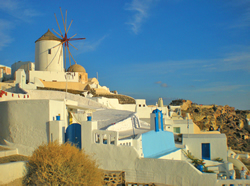
The town of Oia on Santorini.

The southern stretch of Santorini
In the southern reaches of the Aegean Sea, just above the Sea of Crete, is a barren, lava-charred paradise in the sun called Santorini. Antiquity’s first great mariners lived on its calm vistas of brush and rock. When the island’s volcano triggered a world-wide cataclysm halfway though the second millennium B.C., the innovative Minoans who had made it home passed into Greek legend — probably inspiring Plato’s Atlantis — and the island itself transformed into today’s shattered landscape of charred cliffs and parched plateaus — a high, broken desert caught between cerulean waves and crystal blue skies.
Most travelers enter Santorini through its main city of Fira, which is stacked with cafes, taverns, wine bars, donkey handlers and churches, all lined across a herculean ledge overlooking the sea. But the island’s best moments are found to its far north and its far south. In the north is Oia, a pearly white village of bleached walls, old stone and piercing azure domes against the horizon. The town is nearly blinding in the sun, while its spellbinding classicality makes you feel like you’re in a living piece of art.
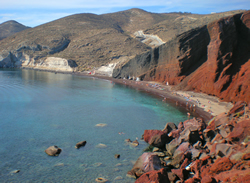
Red Beach on Santorini
At the furthest southern point of Santorini are Minoan ruins that date back to the great destruction. Similar to Pompeii, the city of Akrotiri was forever preserved by the volcano that ended it. Today, this archeological site represents the oldest ruins from the ancient world outside of Egypt and Mesopotamia. Walking twenty-minutes from Akrotiri you can find Red Beach, a green, glassy shield of water lapping against crimson boulders and a rust-red cliff. The sparse beach in this unearthly setting allows for some of the best swimming in the entire Aegean. The path to Red Beach is empty and dusty, save for wind-wrecked vineyards on the hills and a few men roasting corncobs on fires in the afternoon heat; but when you arrive at the cove of sun worshipping, it can alter your consciousness: The volcano that erupted centuries ago transformed this piece of Santorini into a harsh, riven picture of blood-colored soil. When you stand on its sand, looking out to the glimmering expanse of the Mediterranean, you see the same possibilities Homer did when our heritage of art and literature was first starting — you see a bright, open world that seems virtually limitless.
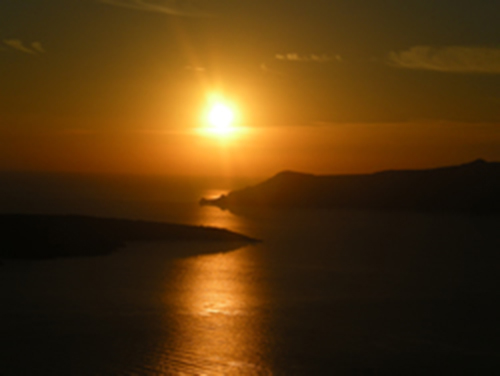
A Santorini sunset in Thera.
